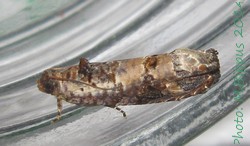Biology:Dudua aprobola
| Dudua aprobola | |
|---|---|

| |
| Scientific classification | |
| Kingdom: | Animalia
|
| Phylum: | |
| Class: | |
| Order: | |
| Family: | |
| Genus: | |
| Species: | D. aprobola
|
| Binomial name | |
| Dudua aprobola (Meyrick, 1886)
| |
| Synonyms | |
| |
Dudua aprobola, the mango flower webworm[1] or litchi leaf roller, is a moth of the family Tortricidae. The species was first described by Edward Meyrick in 1886.[2] It is a pest on several economically important crops.[3]
Distribution
It is found in Taiwan, Japan ,[4] the Seychelles, Nepal, India , the Chagos Archipelago, Sri Lanka,[5] the Maldives, Myanmar, Vietnam, Thailand, western Malaysia, Sumatra, Java, Bali, Brunei, Kalimantan, the Philippines , Sulawesi, Buru, Ambon, New Guinea, the D'Entrecasteaux Islands, Australia ,[6] the Admiralty Islands, New Ireland, the Caroline Islands, the Gilbert Islands, Fiji, Tonga, Samoa, Réunion, Malawi and Rwanda.
Description
Adult wingspan is about 19 mm.[7] The female lays eggs between veins on the undersides of leaves of the food plant. The caterpillar is translucent yellowish green. First two pairs of legs are black. The larvae roll or web the leaves of the food plant together, feeding on them within this shelter. They sometimes live in flowers.[8] Pupation takes place inside a rolled leaf, which is lined by a thin layer of silk. The pupation period lasts one to two weeks. Adult has pale brownish forewings with various dark markings. Hindwings are plain brown. On thorax region, there is a crest of dark scales.[9]
Larval food plants
- Anacardium sp.
- Arachis hypogaea
- Bidens pilosa
- Calophyllum inophyllum
- Cassia tora
- Dahlia sp.
- Eucalyptus sp.
- Eugenia jambos
- Ficus sp.
- Flemingia macrophylla
- Lagerstroemia speciosa
- Lagerstroemia sp.
- Lantana camara
- Litchi chinensis
- Loranthus sp.
- Mangifera indica
- Metrosideros collina
- Metrosideros villosa
- Nephelium litchi
- Plumbago zeylanica
- Polyalthia longifolia
- Psidium guajava
- Rosa sp.
- Salix tetrasperma
- Schleichera trijuga
Control and management
Adults and caterpillars can be controlled by hand picking and pruning. Egg and larval parasitoids are also effective. Pesticides and use of Bacillus thuringiensis extracts are effective against caterpillars.[1]
References
- ↑ 1.0 1.1 "Mango flower webworm". Pacific Pests and Pathogens - Fact Sheets. http://www.pestnet.org/fact_sheets/mango_flower_webworm_334.htm.
- ↑ "Species Details: Dudua aprobola Meyrick, 1886". http://www.catalogueoflife.org/col/details/species/id/53c9561835c94202da22fb4db28cae63.
- ↑ "Leaf-curling Moth". Cook Islands Biodiversity Database. http://cookislands.bishopmuseum.org/species.asp?id=7300.
- ↑ "オオセンダンヒメハマキ Dudua aprobola (Meyrick, 1886)". http://www.jpmoth.org/Tortricidae/Olethreutinae/Dudua_aprobola.html.
- ↑ Koçak, Ahmet Ömer; Kemal, Muhabbet (20 February 2012). "Preliminary list of the Lepidoptera of Sri Lanka". Cesa News (Centre for Entomological Studies Ankara) (79): 1–57. https://www.academia.edu/1782757/Ko%C3%A7ak_A.%C3%96._and_M._Kemal_2012_Preliminary_list_of_the_Lepidoptera_of_Sri_Lanka._Cesa_News_79_1-57.
- ↑ Diakonoff, A. (1982). "On a Collection of Some Families of Micro-Lepidoptera from Sri Lanka (Ceylon)". Zoologische Verhandelingen 193: 1–124. http://www.repository.naturalis.nl/document/149137.
- ↑ "Dudua aprobola Micromoth". https://indiabiodiversity.org/observation/show/323606.
- ↑ "Dudua aprobola (Meyrick)". ICAR-National Bureau of Agricultural Insect Resources. http://www.nbair.res.in/insectpests/Dudua-aprobola.php.
- ↑ "Biology of Dudua aprobola (Meyrick, 1886)". Butterfly House. http://lepidoptera.butterflyhouse.com.au/tort/aprobola.html.
External links
| Wikimedia Commons has media related to Dudua aprobola. |
- Eurasian Tortricidae
- Prevalence of some threatening pests and disease of Litchi (Litchi chinensis Sonn.) in Bihar state of India
- Field efficacy of insecticides and integrated pest management modules against litchi leaf roller, Dudua aprobola
- Diversity and economic status of Lepidopteran insect-pest on two major varieties of mango
- Development of chemical control against the leaf webber, Dudua aprobola (Meyr.) on litchi
Wikidata ☰ Q5312096 entry
 |

